Abstract
Use of oral rehydration salts is an effective tool to decrease deaths due to diarrheal dehydration. Following concerted educational efforts to introduce oral rehydration therapy, Nicaragua reported a significant decrease in deaths of young children from diarrhea and dehydration over a 5-year period. Further decline in the mortality rate has not occurred, however, and factors that would affect usage and impact are poorly understood. A health survey was administered in 155 randomly selected homes in Matiguas, Nicaragua, in July 1990. Caretakers of children were asked about their knowledge, attitudes, and practices in treating diarrhea in children younger than age 5. They were also asked to demonstrate their knowledge of mixing World Health Organization oral rehydration salts packets. Ninety percent of the respondents said they used oral rehydration therapy. The major reason quoted for not using it was dislike of the taste. Of the three-quarters willing to mix the oral rehydration salts, 62 percent prepared the solution correctly and 38 percent incorrectly. Knowledge about diarrhea and the role of oral rehydration therapy was high in this population, and those with this knowledge were more likely to use it. Respondents who learned to mix the oral rehydration salts at the health center had more years of education and were more likely to mix the salts correctly. In this study, there is a positive association between contact with the health center and correct use of the rehydration salts. The relationship of this association with morbidity and mortality needs further research.
Full text
PDF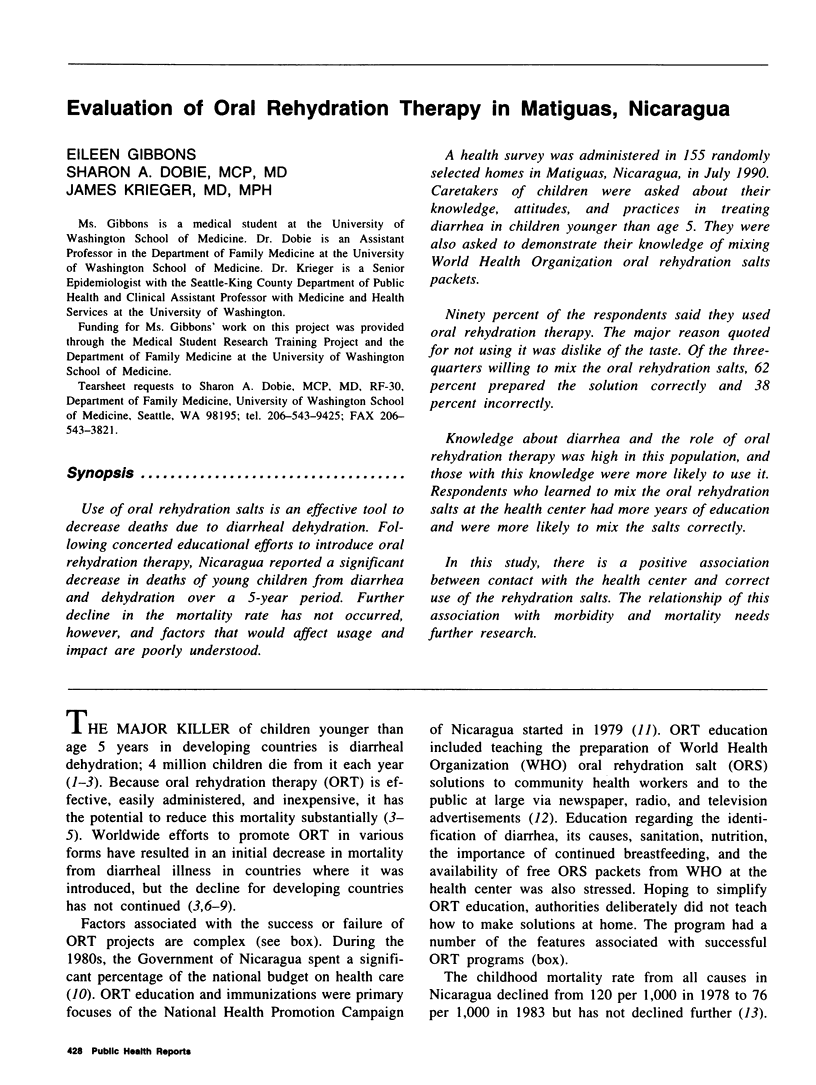
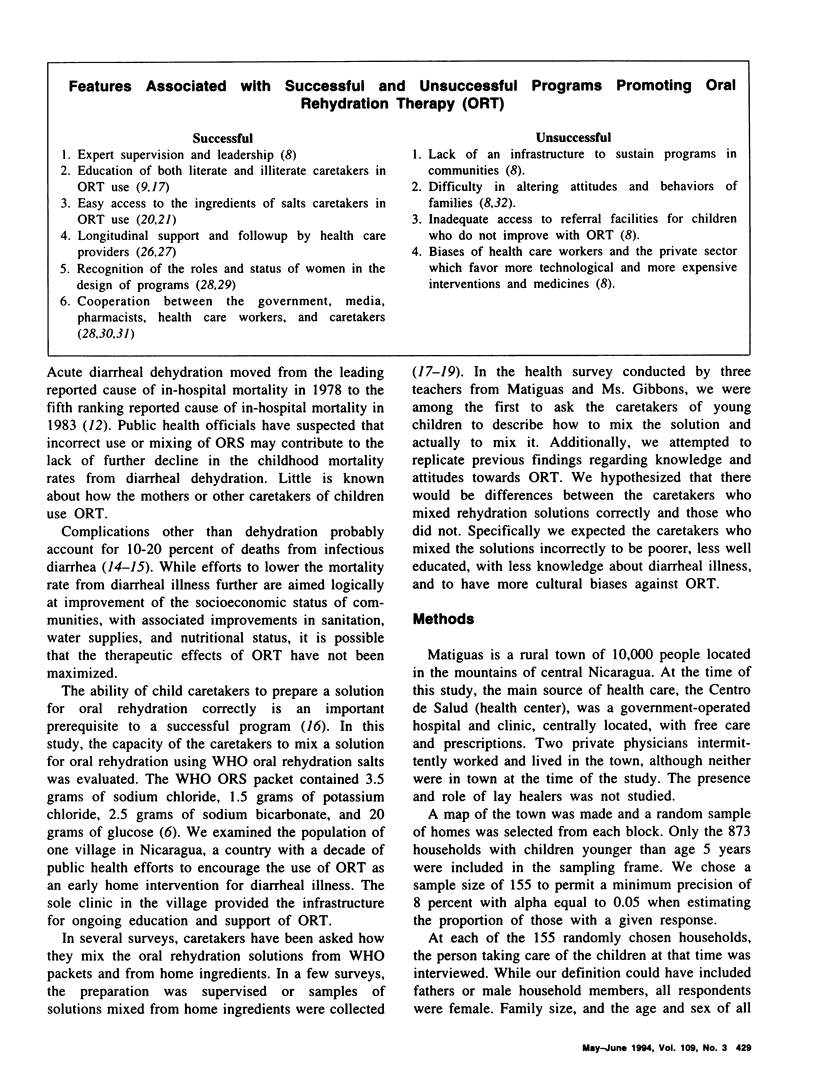
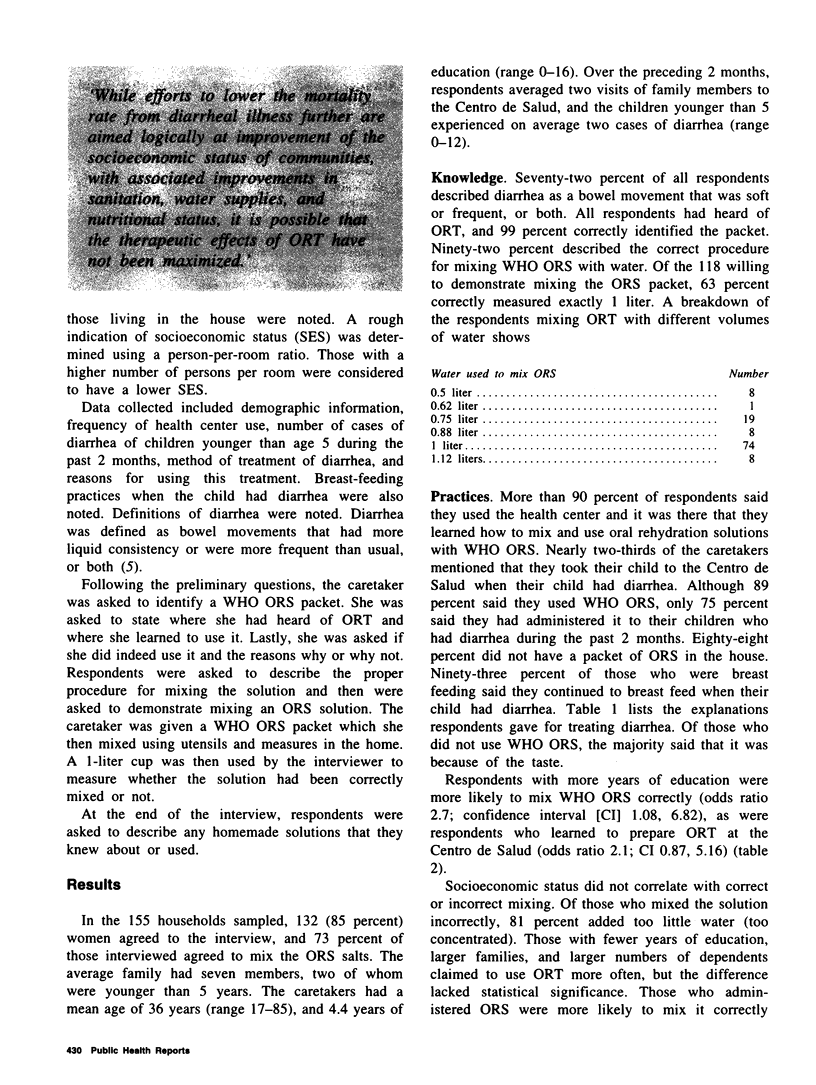
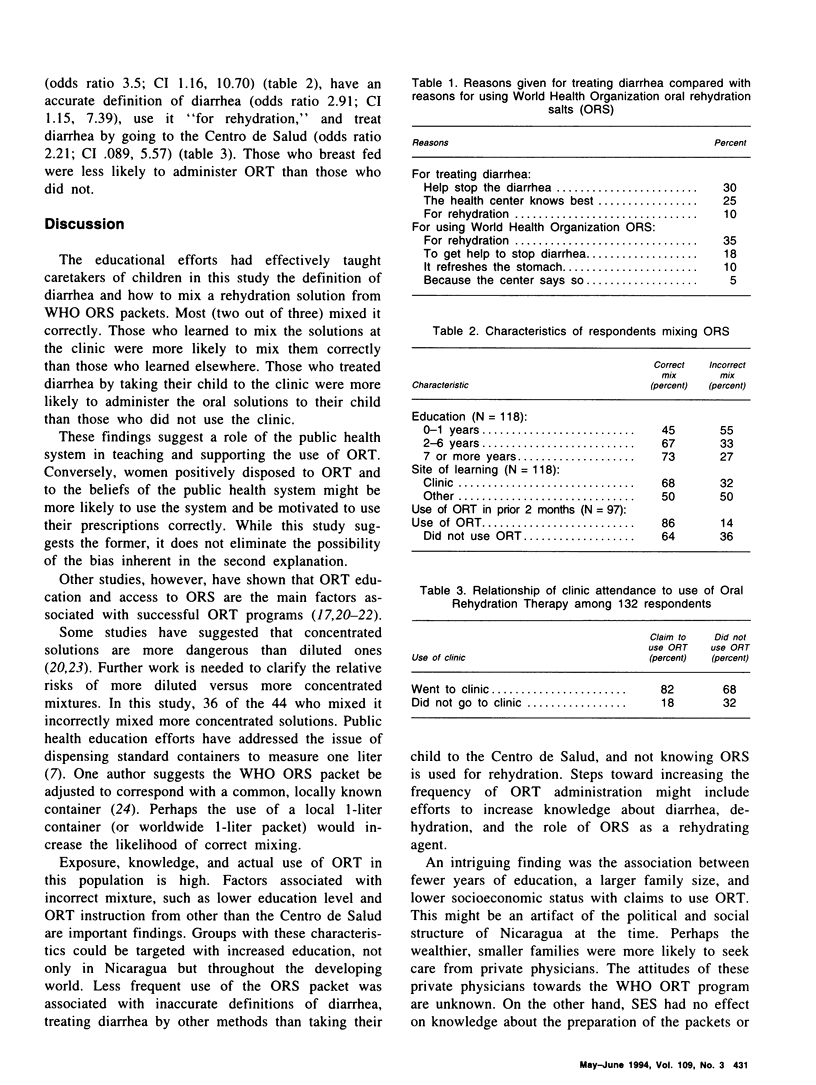
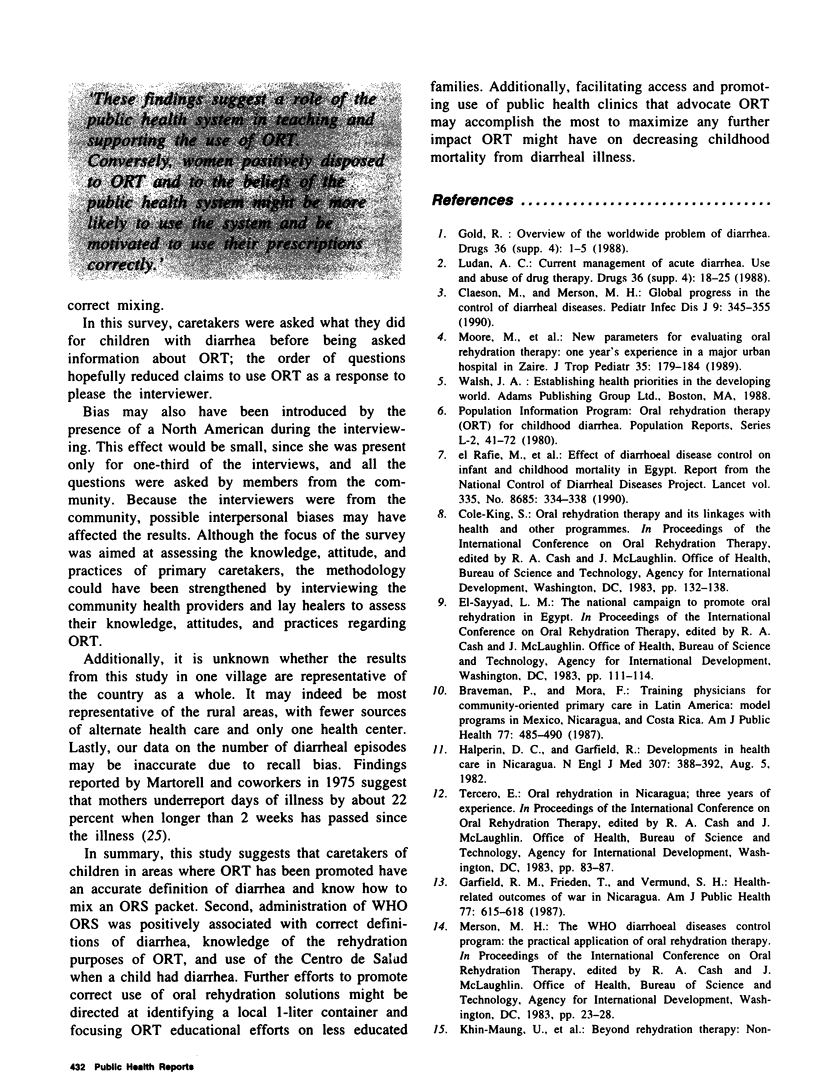
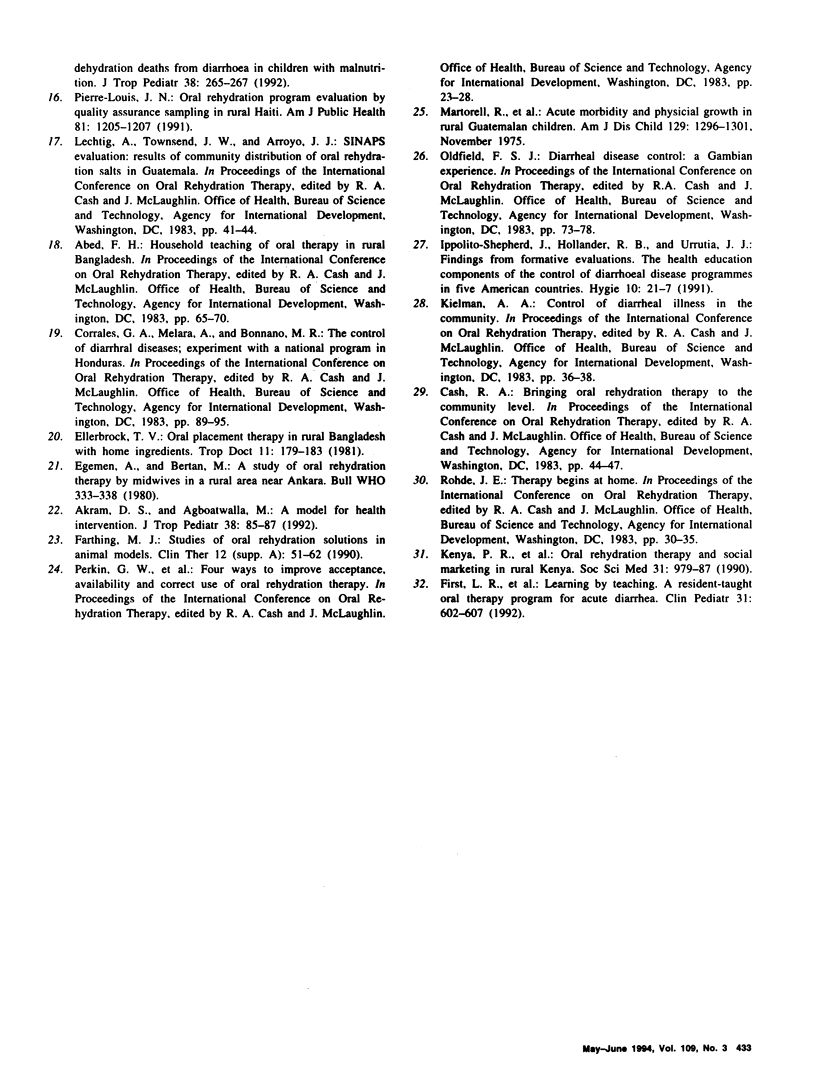
Selected References
These references are in PubMed. This may not be the complete list of references from this article.
- Akram D. S., Agboatwalla M. A model for health intervention. J Trop Pediatr. 1992 Apr;38(2):85–87. doi: 10.1093/tropej/38.2.85. [DOI] [PubMed] [Google Scholar]
- Braveman P. A., Mora F. Training physicians for community-oriented primary care in Latin America: model programs in Mexico, Nicaragua, and Costa Rica. Am J Public Health. 1987 Apr;77(4):485–490. doi: 10.2105/ajph.77.4.485. [DOI] [PMC free article] [PubMed] [Google Scholar]
- Claeson M., Merson M. H. Global progress in the control of diarrheal diseases. Pediatr Infect Dis J. 1990 May;9(5):345–355. doi: 10.1097/00006454-199005000-00008. [DOI] [PubMed] [Google Scholar]
- Ellerbrock T. V. Oral replacement therapy in rural Bangladesh with home ingredients. Trop Doct. 1981 Oct;11(4):179–183. doi: 10.1177/004947558101100410. [DOI] [PubMed] [Google Scholar]
- Farthing M. J. Studies of oral rehydration solutions in animal models. Clin Ther. 1990;12 (Suppl A):51–62. [PubMed] [Google Scholar]
- First L. R., Lauerman R., Fenton T., Herzog L., Snyder J. D. Learning by teaching. A resident-taught oral therapy program for acute diarrhea. Clin Pediatr (Phila) 1992 Oct;31(10):602–607. doi: 10.1177/000992289203101005. [DOI] [PubMed] [Google Scholar]
- Garfield R. M., Frieden T., Vermund S. H. Health-related outcomes of war in Nicaragua. Am J Public Health. 1987 May;77(5):615–618. doi: 10.2105/ajph.77.5.615. [DOI] [PMC free article] [PubMed] [Google Scholar]
- Halperin D. C., Garfield R. Developments in health care in Nicaragua. N Engl J Med. 1982 Aug 5;307(6):388–392. doi: 10.1056/NEJM198208053070634. [DOI] [PubMed] [Google Scholar]
- Ippolito-Shepherd J., Hollander R. B., Urrutia J. J. Findings from formative evaluations. The health education components of the control of diarrhoeal disease programmes in five American countries. Hygie. 1991 Jun;10(2):21–27. [PubMed] [Google Scholar]
- Kenya P. R., Gatiti S., Muthami L. N., Agwanda R., Mwenesi H. A., Katsivo M. N., Omondi-Odhiambo, Surrow A., Juma R., Ellison R. H. Oral rehydration therapy and social marketing in rural Kenya. Soc Sci Med. 1990;31(9):979–987. doi: 10.1016/0277-9536(90)90107-4. [DOI] [PubMed] [Google Scholar]
- Khin-Maung-U, Nyunt-Nyunt-Wai, Myo-Khin, Myo-Min-Aung, Thaung U. Beyond rehydration therapy: non-dehydration deaths from diarrhoea in children with malnutrition. J Trop Pediatr. 1992 Oct;38(5):265–267. doi: 10.1093/tropej/38.5.265. [DOI] [PubMed] [Google Scholar]
- Ludan A. C. Current management of acute diarrhoeas. Use and abuse of drug therapy. Drugs. 1988;36 (Suppl 4):18–25. doi: 10.2165/00003495-198800364-00005. [DOI] [PubMed] [Google Scholar]
- Martorell R., Habicht J. P., Yarbrough C., Lechtig A., Klein R. E., Western K. A. Acute morbidity and physical growth in rural Guatemalan children. Am J Dis Child. 1975 Nov;129(11):1296–1301. doi: 10.1001/archpedi.1975.02120480022007. [DOI] [PubMed] [Google Scholar]
- Moore M., Davachi F., Bongo L., Seruvugo H., Mushiya K., Roy J. A., Mambu-ma-Disu New parameters for evaluating oral rehydration therapy: one year's experience in a major urban hospital in Zaire. J Trop Pediatr. 1989 Aug;35(4):179–184. doi: 10.1093/tropej/35.4.179. [DOI] [PubMed] [Google Scholar]
- Pierre-Louis J. N. Oral rehydration program evaluation by quality assurance sampling in rural Haiti. Am J Public Health. 1991 Sep;81(9):1205–1207. doi: 10.2105/ajph.81.9.1205. [DOI] [PMC free article] [PubMed] [Google Scholar]
- el-Rafie M., Hassouna W. A., Hirschhorn N., Loza S., Miller P., Nagaty A., Nasser S., Riyad S. Effect of diarrhoeal disease control on infant and childhood mortality in Egypt. Report from the National Control of Diarrheal Diseases Project. Lancet. 1990 Feb 10;335(8685):334–338. doi: 10.1016/0140-6736(90)90616-d. [DOI] [PubMed] [Google Scholar]


